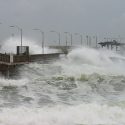Satellites give an eagle eye on thunderstorms
It’s one of the more frustrating parts of summer. You check the weather forecast, see nothing dramatic, and go hiking or biking. Then, four hours later, a thunderstorm appears out of nowhere and ruins your afternoon.
Thunderstorms can bring intense rain, hail, lightning and even tornadoes, but “predicting them a few hours out is one of the great problems of meteorology,” says Chian-Yi Liu, a postdoctoral researcher at the University of Wisconsin–Madison.
And the consequences can be more serious than a rained-out hike — even major storms can be missed, Liu says, including the one that dumped up to 10 inches of rain on La Crosse, Wis., on Aug. 18, 2007. “Predictions for the day said a moderate chance of thunderstorms,” Liu says, “but this one produced an inch or two of rain per hour and caused severe flooding.”
Thunderstorms are called “convective storms” because they are powered by differences in air density that cause updrafts and cooling, and can lead to hail, rain, tornadoes and lightning.
In a presentation at the meeting of the American Geophysical Union in San Francisco on Dec. 16, Liu will show that additional data, taken from a satellite, could greatly improve the accuracy of thunderstorm prediction a few hours out.
Liu works at the Cooperative Institute of Meteorological Satellite Studies (CIMSS) at UW–Madison, which both processes satellite data and explores how meteorologists can use more effectively.
“Scientists understand the basic causes of thunderstorm formation,” Liu says, “but their major source of data is usually surface observations, or measurements taken from balloons that are released into the lower atmosphere, and they usually lack information about the upper atmosphere.”
When Liu and his colleagues introduced data on conditions at 15,000-32,000 feet of altitude into the equation, they found a considerable improvement in the crucial three- to six-hour forecast. The data was collected from 400 different events by sensors on NASA’s Aqua satellite that measure conditions at different altitudes.
Convective storms allow the atmosphere to dump excess energy, held in the form of heat and humidity, and release it as wind and especially precipitation. Convection storms are most likely when the atmosphere is unstable, Liu says. “Our analysis shows that if there is instability at around 30,000 feet, with other storm-favorable conditions, a convective storm will develop in the following three to five hours. Using the top-down view of a satellite reverses our usual way of thinking about convective storms, and may suggest an explanation for storms that arise when they would not be predicted using conventional methods.”
“For a long time, we have looked at convection and instability from a near-surface perspective,” says co-author Steve Ackerman, a professor of meteorology and director of CIMSS. “What Chian-Yi has showed is that this is not always the case, you can drive instability from upper troposphere too.”
The troposphere is roughly the lower six miles of the atmosphere.
Convection releases energy and feeds on itself, Ackerman says. “If you have unstable conditions in the atmosphere and things get moving, they will continue to move by themselves. Our perspective has been how it could get started from the ground. Chian-Yi has shown that it can start from the top as well.”
CIMSS has a good working relationship with National Weather Service, Ackerman says, and has a “proving ground” process that can quickly incorporate research results into forecast methods.
“In my experience, there are not many advances that come along with so much potential to improve forecasts,” Ackerman says. “This is an advance in the science, and it takes this perspective: Let’s not always look at the atmosphere from the ground. Let’s also look at what happens in the upper atmosphere.”

